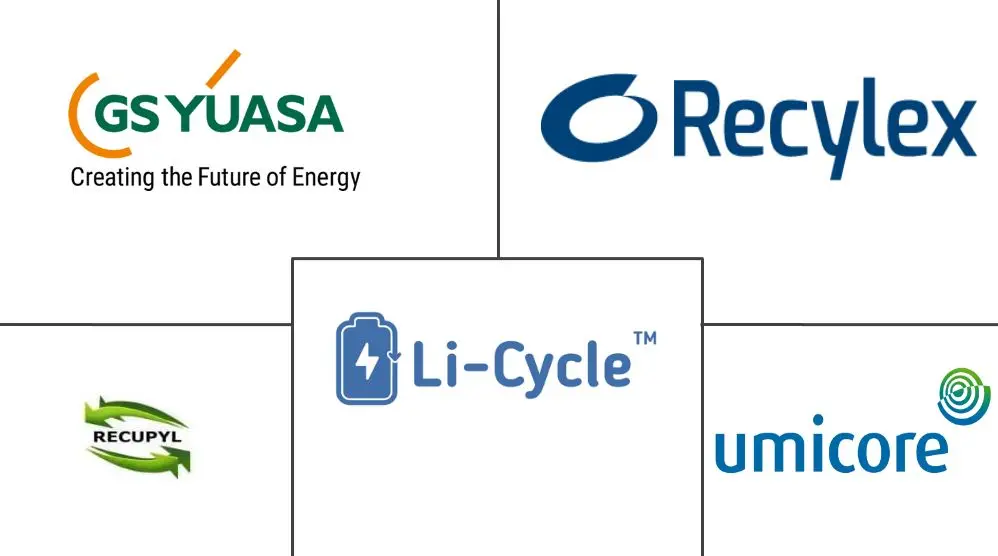Lithium-ion Battery Recycling Market Size and Share
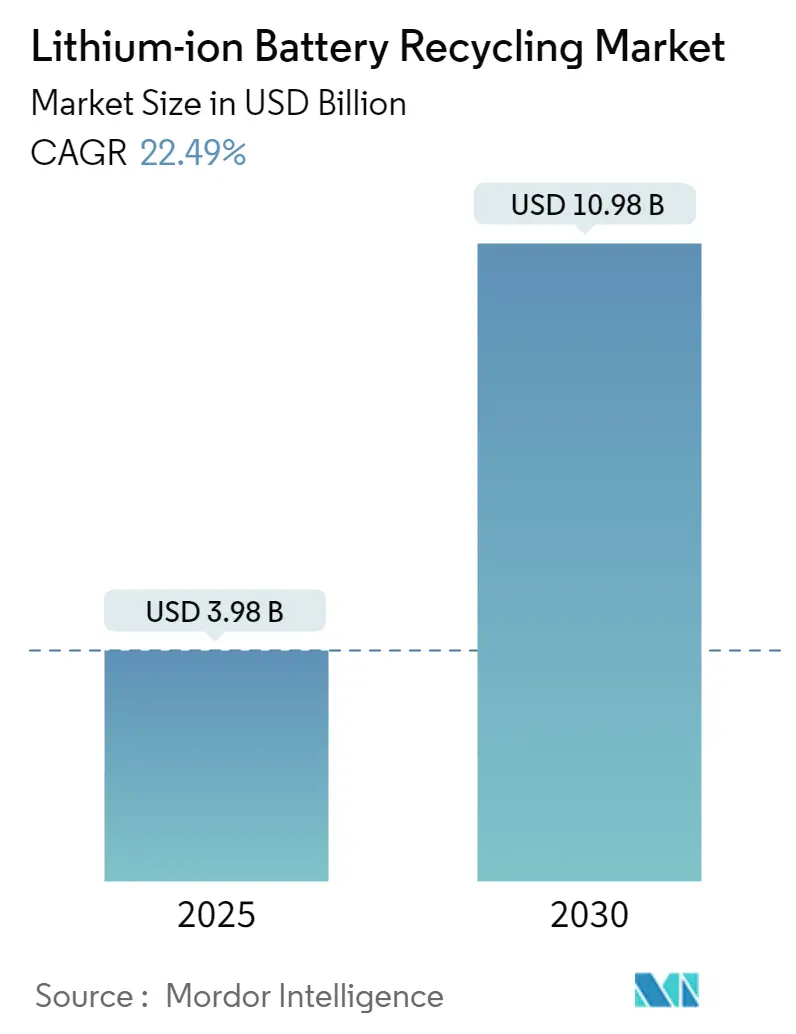
Lithium-ion Battery Recycling Market Analysis by Mordor Intelligence
The Lithium-ion Battery Recycling Market size is estimated at USD 3.98 billion in 2025, and is expected to reach USD 10.98 billion by 2030, at a CAGR of 22.49% during the forecast period (2025-2030).
The lithium-ion battery recycling market is experiencing rapid transformation driven by increasing environmental consciousness and resource sustainability imperatives. According to the International Energy Agency, the automotive lithium-ion battery demand reached 340 GWh in 2021, with projections indicating a substantial increase to 3,500 GWh by 2030. This exponential growth in battery demand has created an urgent need for efficient recycling solutions, as the IEA estimates that battery waste could reach 8 million tonnes by 2040. The industry is witnessing a significant shift towards developing more sophisticated recycling technologies, with companies investing heavily in research and development to improve recovery rates of critical materials.
The regulatory landscape is evolving rapidly to support sustainable battery management practices. In December 2022, the European Union implemented comprehensive battery regulations that mandate specific recovery rates for major battery metals—98% for nickel, cobalt, and manganese, and 85% for lithium. These regulations have catalyzed investments in recycling infrastructure and technology development, with several major companies announcing expansion plans. The industry is seeing a trend towards the integration of advanced technologies such as artificial intelligence and automation in lithium-ion battery recycling processes to improve efficiency and recovery rates.
The recycling technology landscape is diversifying, with companies adopting various approaches including hydrometallurgical, pyrometallurgical, and mechanical processes. According to the World Economic Forum, the battery market consumed approximately 74% of global lithium production in 2021, highlighting the critical need for efficient recycling solutions. The industry is witnessing increased adoption of hydrometallurgical processes due to their higher recovery efficiency and lower energy consumption compared to traditional methods. Companies are increasingly focusing on developing closed-loop recycling systems that can recover multiple materials simultaneously while maintaining high purity levels.
The market is characterized by strategic partnerships and vertical integration initiatives across the battery value chain. Major battery manufacturers are establishing dedicated recycling divisions or partnering with specialized recycling companies to secure their supply chains. The electric vehicle sector, which accounted for 47% of lithium demand in 2021, is driving significant investments in recycling infrastructure. Industry players are increasingly focusing on developing more efficient collection systems and standardized processes for handling end-of-life batteries, with several companies announcing plans for large-scale recycling facilities across major markets. The lithium-ion battery recycling market size is expected to expand significantly as these developments unfold.
Global Lithium-ion Battery Recycling Market Trends and Insights
Declining Battery Prices and Growing Electric Vehicle Adoption
The dramatic decline in lithium-ion battery prices has been a fundamental driver for the recycling market's growth. Battery prices have witnessed a steep decline over the past decade, with prices reaching USD 176 per kWh in 2018 and projected to further decrease to approximately USD 100/kWh by 2025. This price reduction has been achieved through sustained R&D efforts focused on improving battery materials, reducing non-active material usage, enhancing cell design, and increasing production yields. The improved cost-competitiveness has led to widespread adoption across various applications, particularly in the automotive sector, creating a larger pool of batteries that will eventually require recycling.
The automotive industry's aggressive push toward electrification has created a significant future recycling opportunity. Major automotive manufacturers are setting ambitious targets for electric vehicle production and sales. For instance, in March 2023, Honda announced plans to manufacture lithium-ion batteries in the United States through a joint venture with LG Energy Solutions. The USD 4.4 billion factory aims to begin large-scale production of lithium-ion battery cells by the end of 2025. Such investments and commitments from automotive manufacturers are creating a substantial future supply of end-of-life batteries that will require recycling solutions from electric vehicle battery recycling companies.
Stringent Government Regulations and Environmental Mandates
Government regulations and environmental mandates have emerged as powerful drivers for the lithium-ion battery recycling companies market. In December 2022, the EU Parliament and Council reached a landmark agreement to overhaul battery regulations, implementing strict requirements for battery lifecycle management. The new regulations mandate specific recovery rates for major battery metals - 98% for nickel, cobalt, and manganese, and 85% for lithium. Additionally, manufacturers must now provide detailed information about battery contents, proper disassembly procedures, and environmental impact assessments, creating a more structured framework for the recycling industry.
The implementation of extended producer responsibility and mandatory recycling targets has further accelerated market growth. For instance, the EU has set ambitious collection targets of 45% by 2023, increasing to 73% by 2030 for portable batteries, and 51% by 2028, rising to 61% by 2031 for light means of transport batteries. These regulations are complemented by requirements that new batteries must incorporate minimum recycled content - 16% for cobalt, 85% for lead, and 6% each for lithium and nickel sourced from manufacturing and consumer waste. Such comprehensive regulatory frameworks are compelling manufacturers and stakeholders to invest in recycling infrastructure and technologies, benefiting battery recycling companies.
Rising Demand from Energy Storage Applications
The exponential growth in energy storage applications has created a significant driver for the lithium battery recycling companies market. The integration of renewable energy sources into power grids has necessitated large-scale energy storage solutions, leading to increased deployment of lithium-ion batteries in grid-scale storage systems. These batteries play a crucial role in addressing intermittency issues associated with renewable energy sources, providing grid stability, and enabling peak shaving applications. As these storage systems reach their end-of-life, they create a substantial recycling opportunity.
The residential and commercial energy storage sector has also emerged as a significant driver for battery recycling. The declining costs of solar PV systems combined with energy storage solutions have made self-consumption more attractive for both residential and commercial customers. This trend is particularly evident in the growing adoption of home storage systems (HSS) and behind-the-meter storage solutions. As these installations continue to proliferate, they create a steady stream of batteries that will require recycling at the end of their operational life, further driving the growth of the recycling market.
Segment Analysis: End-User Industry
Automotive Segment in Lithium-ion Battery Recycling Market
The automotive segment dominates the global lithium-ion battery recycling market, accounting for approximately 75% of the total market share in 2024. This segment's prominence is primarily driven by the rapid adoption of electric vehicles (EVs) worldwide and stringent regulations regarding battery disposal and recycling. The segment's leadership position is further strengthened by major automotive manufacturers increasingly investing in recycling infrastructure and establishing partnerships with recycling companies. The growing focus on sustainable practices in the automotive industry, coupled with the rising need to secure critical battery materials, has made the automotive battery recycling market a crucial component of the circular economy. Additionally, the segment is witnessing significant technological advancements in recycling processes, particularly in hydrometallurgical and mechanical recycling methods, which are improving recovery rates and reducing processing costs.
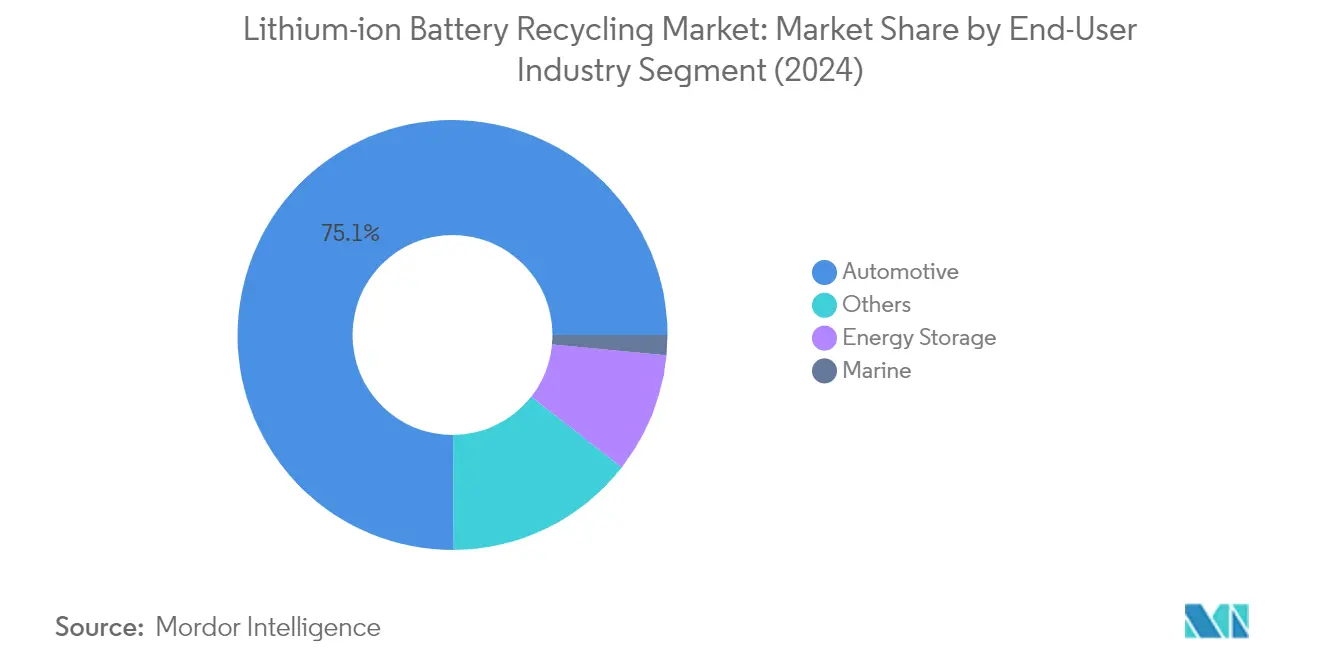
Marine Segment in Lithium-ion Battery Recycling Market
The marine segment represents an emerging opportunity in the lithium-ion battery recycling market, with significant growth potential driven by increasing adoption of electric propulsion systems in marine vessels. The segment is experiencing notable expansion due to stringent environmental regulations in the maritime industry and the growing focus on reducing carbon emissions from shipping operations. The development of specialized recycling processes for marine batteries, which often have different specifications and requirements compared to automotive batteries, is contributing to the segment's growth. Additionally, ports and maritime authorities are establishing dedicated collection and recycling infrastructure for end-of-life marine batteries, further supporting segment expansion. The increasing electrification of ferries, leisure boats, and commercial vessels is expected to generate a steady stream of recyclable batteries in the coming years.
Remaining Segments in End-User Industry
The energy storage and other end-user segments play vital roles in shaping the lithium-ion battery recycling market landscape. The energy storage segment is particularly significant due to the growing deployment of grid-scale battery storage systems and renewable energy integration projects. This segment benefits from the increasing focus on sustainable energy solutions and the need to manage end-of-life batteries from utility-scale installations. The other end-user industries segment, which includes consumer electronics, industrial applications, and power tools, contributes to market diversity through varied recycling requirements and material recovery opportunities. These segments are characterized by different battery chemistries and form factors, necessitating specialized recycling approaches and technologies.
Segment Analysis: Technology
Hydrometallurgical Process Segment in Lithium-ion Battery Recycling Market
The hydrometallurgical process dominates the global lithium-ion battery recycling market, accounting for approximately 45% market share in 2024. This technology's prominence stems from its superior recovery efficiency and lower energy consumption compared to other methods. The process primarily uses aqueous solutions to extract and separate metals from lithium-ion batteries, with recovery rates reaching up to 98% for metals like nickel, cobalt, and manganese, while achieving over 85% recovery for lithium. Major companies like Li-Cycle, GEM, and SungEel HiTech have established significant hydrometallurgical processing facilities globally, demonstrating the technology's commercial viability and scalability.
Physical/Mechanical Process Segment in Lithium-ion Battery Recycling Market
The physical/mechanical process segment is experiencing rapid growth in the electric vehicle battery recycling market for the period 2024-2029. This growth is driven by the technology's advantages, including shorter recovery routes, lower energy consumption, and enhanced environmental friendliness compared to traditional methods. The process involves separating different components of the black mass through physical processes like gravity separation, enabling recovery of cathode material that can be reused with minimal treatment. The technology's cost-effectiveness, demonstrated by its lower processing cost of approximately $1.9 per kg compared to other methods, makes it increasingly attractive to recycling operators and battery manufacturers.
Remaining Segments in Technology
The pyrometallurgical process segment continues to play a significant role in the recycled lithium-ion battery market, particularly in combination with hydrometallurgical processes. This technology offers advantages such as simple operation and no requirement for battery categorization, making it suitable for processing mixed battery waste. However, its higher energy consumption and environmental impact have led to its gradual replacement by more efficient technologies in new recycling facilities. Many established players like Umicore and Glencore utilize a combination of pyrometallurgical and hydrometallurgical processes to optimize their recycling operations.
Lithium-ion Battery Recycling Market Geography Segment Analysis
Lithium-ion Battery Recycling Market in North America
The North America lithium-ion battery recycling market has emerged as a significant player in the global landscape, holding approximately 18% of the global market share in 2024. The region's market is primarily driven by robust government support and increasing environmental regulations promoting sustainable battery disposal practices. The lithium-ion battery recycling market in the US leads the regional market with substantial investments in recycling infrastructure and technology development, particularly through public-private partnerships and state-level programs. The presence of major automotive manufacturers and their growing electric vehicle production has created a strong ecosystem for battery recycling. Canada complements this growth with its advanced research capabilities and focus on developing innovative recycling technologies, while Mexico shows emerging potential with increasing awareness about sustainable practices. The region's market is characterized by sophisticated collection networks, advanced processing facilities, and growing collaboration between battery manufacturers and recycling companies.
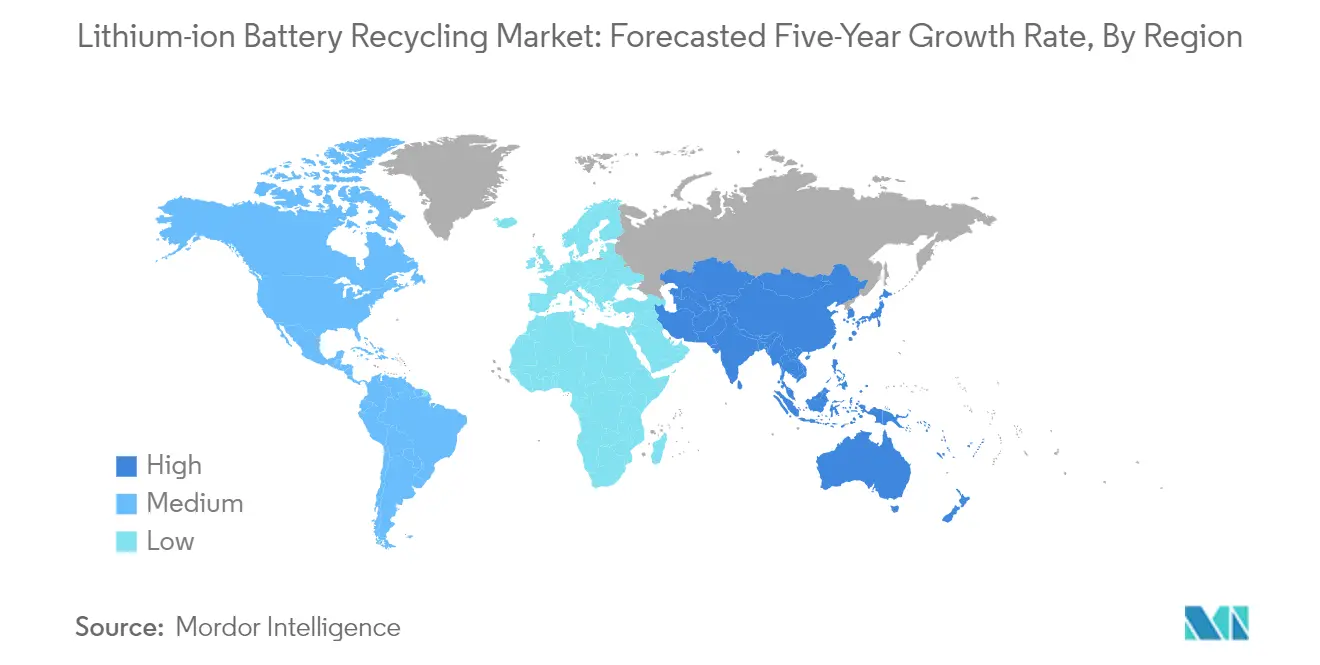
Lithium-ion Battery Recycling Market in Asia-Pacific
The Asia-Pacific region dominates the global lithium-ion battery recycling market, demonstrating remarkable growth with an impressive compound annual growth rate of approximately 21% from 2019 to 2024. The region's supremacy is anchored by China's robust recycling infrastructure and comprehensive regulatory framework, particularly following the implementation of extended producer responsibility policies. Japan and South Korea have established themselves as technological leaders in the recycling space, with their advanced processing capabilities and innovative recycling methodologies. The region benefits from its strong manufacturing base in electronics and electric vehicles, creating a natural ecosystem for battery recycling. The presence of major battery manufacturers, coupled with increasing government support for sustainable practices, has created a favorable environment for market expansion. The region's recycling capabilities span across various technologies, including hydrometallurgical, pyrometallurgical, and mechanical processes, ensuring efficient recovery of valuable materials.
Lithium-ion Battery Recycling Market in Europe
The European lithium-ion battery recycling market is poised for substantial growth, with projections indicating a robust compound annual growth rate of approximately 22% from 2024 to 2029. The region's market is shaped by stringent EU regulations and ambitious sustainability targets, particularly the comprehensive battery lifecycle regulations implemented across member states. Germany leads the European market with its advanced recycling infrastructure and strong automotive sector presence. The region's commitment to circular economy principles and sustainable manufacturing practices has fostered innovation in recycling technologies. Countries like Belgium, France, and the Nordic nations have developed specialized expertise in different aspects of battery recycling, creating a diverse and complementary ecosystem. The market benefits from strong collaboration between research institutions, industry players, and government bodies, driving technological advancement and process optimization.
Lithium-ion Battery Recycling Market in South America
The South American lithium-ion battery recycling market presents unique opportunities and challenges, characterized by its rich lithium resources and growing environmental consciousness. The region's market is primarily driven by increasing adoption of renewable energy solutions and growing awareness about sustainable practices. Brazil leads the regional market with its industrial infrastructure and growing focus on environmental regulations. Chile and Argentina, despite being major lithium producers, are gradually developing their recycling capabilities to create a more sustainable battery value chain. The region's market is characterized by emerging partnerships between local and international players, focusing on developing efficient recycling technologies suitable for local conditions. The growing adoption of electric vehicles and energy storage systems in urban areas is creating new opportunities for recycling infrastructure development.
Lithium-ion Battery Recycling Market in Middle East & Africa
The Middle East and African lithium-ion battery recycling market is in its nascent stages but shows promising potential for future growth. The region's market is driven by increasing urbanization, rising electronic waste concerns, and growing adoption of renewable energy solutions. The United Arab Emirates leads the regional market with its ambitious sustainability initiatives and circular economy goals. South Africa is emerging as a key market player with its developing infrastructure and growing focus on sustainable waste management practices. The region's market is characterized by increasing investments in recycling infrastructure and growing awareness about environmental protection. Government initiatives promoting sustainable development and waste management are creating new opportunities for market expansion, while partnerships with international technology providers are helping establish modern recycling facilities.
Competitive Landscape
Top Companies in Lithium-ion Battery Recycling Market
The largest lithium battery recycling companies, such as Glencore PLC, Umicore SA, and Li-Cycle Holdings Corp, are leading the innovation frontier in the lithium-ion battery recycling market. These lithium-ion battery recycling companies are increasingly focusing on developing advanced recycling technologies, particularly in hydrometallurgical and mechanical processes, to improve material recovery rates and reduce environmental impact. Strategic partnerships with automotive manufacturers and battery producers have become a crucial trend, enabling secure feedstock supply and downstream material offtake agreements. Market leaders are expanding their geographical footprint through new facility investments, particularly in Europe and North America, while simultaneously scaling up existing operations to meet growing demand. The industry is witnessing significant investment in research and development to optimize recycling processes, reduce operational costs, and enhance the quality of recovered materials.
Dynamic Market Structure with Growing Consolidation
The lithium-ion battery recycling market exhibits a moderately fragmented structure, characterized by a mix of global conglomerates and specialized recycling companies. Large-scale industrial players like Glencore and Umicore leverage their extensive metallurgical expertise and established global networks, while specialized firms such as Li-Cycle and Princeton NuEnergy focus on innovative recycling technologies and regional market penetration. The market is witnessing increased consolidation through strategic acquisitions and joint ventures, as evidenced by SK Ecoplant's acquisition of TES-AMM and Glencore's partnership with Britishvolt.
The competitive dynamics are shaped by varying levels of vertical integration, with some players focusing solely on recycling operations while others extend their presence across the battery value chain. Market participants are increasingly pursuing strategic alliances with battery manufacturers, automotive companies, and mining firms to secure their position in the circular economy. The industry is experiencing a surge in new entrants, particularly technology-focused companies bringing innovative solutions to address efficiency and environmental challenges in the recycling process. Battery recycling shares are becoming more attractive as companies consolidate and innovate.
Innovation and Integration Drive Future Success
Success in the lithium-ion battery recycling market increasingly depends on technological capabilities and strategic positioning within the broader battery value chain. Companies must invest in scalable and efficient recycling technologies while maintaining flexibility to handle various battery chemistries and formats. Building strong relationships with battery manufacturers and automotive companies is crucial for securing consistent feedstock supply and establishing reliable output channels. Regulatory compliance and environmental certifications are becoming increasingly important differentiators, as governments worldwide implement stricter regulations on battery recycling and material recovery.
Market contenders can gain ground by focusing on regional markets with growing battery waste volumes and less established recycling infrastructure. Developing specialized solutions for specific battery types or end-user segments can provide competitive advantages in an increasingly crowded market. The ability to demonstrate environmental benefits and achieve high material recovery rates will become crucial as end-users become more environmentally conscious. Companies must also maintain operational agility to adapt to evolving battery technologies and changing regulatory requirements while building robust logistics networks to efficiently collect and process end-of-life batteries. The lithium recycling business is poised for growth as it aligns with sustainability goals and technological advancements.
Lithium-ion Battery Recycling Industry Leaders
-
GS Yuasa Corporation
-
Li-Cycle Technology
-
Recupyl Sas
-
Glencore PLC
-
Umicore SA
- *Disclaimer: Major Players sorted in no particular order
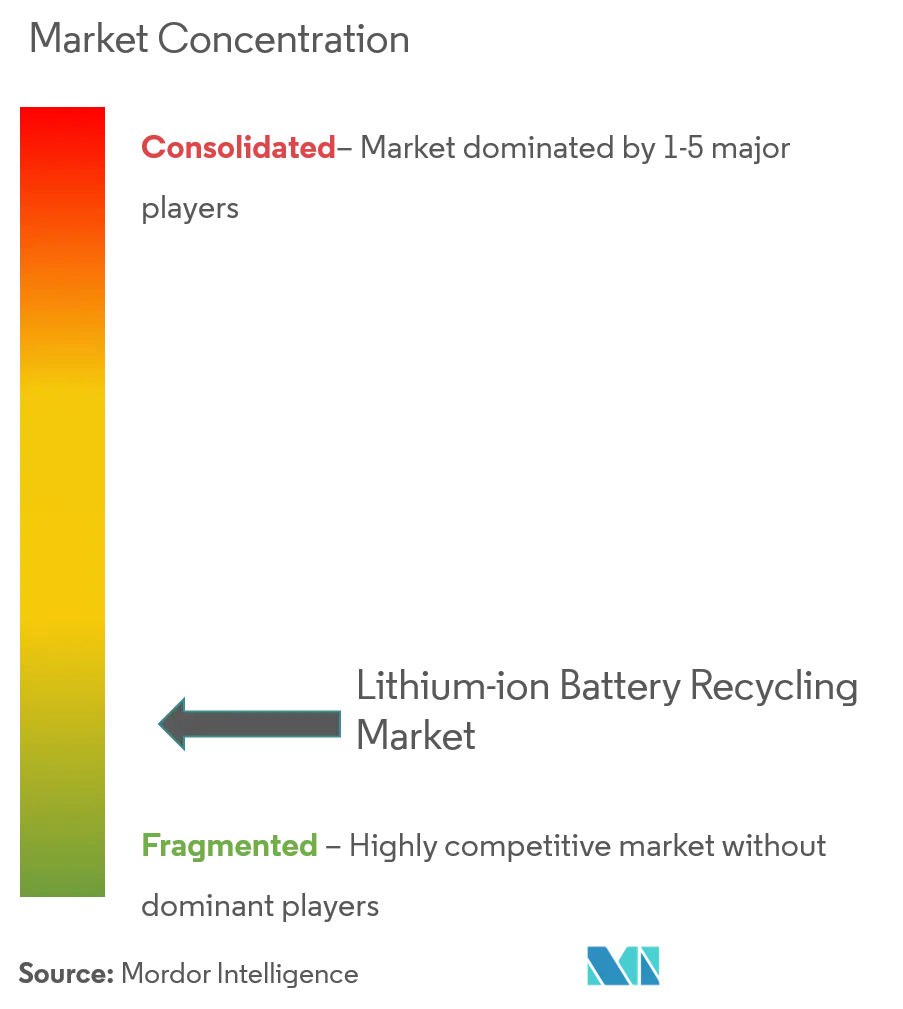
Global Lithium-ion Battery Recycling Market Report Scope
The lithium-ion battery recycling market report include:
| Automotive |
| Marine |
| Power |
| Others |
| Hydrometallurgical Process |
| Pyrometallurgy Process |
| Physical/Mechanical Process |
| North America |
| Asia-Pacific |
| Europe |
| South America |
| Middle-East and Africa |
| Industry | Automotive |
| Marine | |
| Power | |
| Others | |
| Technology | Hydrometallurgical Process |
| Pyrometallurgy Process | |
| Physical/Mechanical Process | |
| Geography | North America |
| Asia-Pacific | |
| Europe | |
| South America | |
| Middle-East and Africa |
Key Questions Answered in the Report
How big is the Lithium-ion Battery Recycling Market?
The Lithium-ion Battery Recycling Market size is expected to reach USD 3.98 billion in 2025 and grow at a CAGR of 22.49% to reach USD 10.98 billion by 2030.
What is the current Lithium-ion Battery Recycling Market size?
In 2025, the Lithium-ion Battery Recycling Market size is expected to reach USD 3.98 billion.
Who are the key players in Lithium-ion Battery Recycling Market?
GS Yuasa Corporation, Li-Cycle Technology, Recupyl Sas, Glencore PLC and Umicore SA are the major companies operating in the Lithium-ion Battery Recycling Market.
Which is the fastest growing region in Lithium-ion Battery Recycling Market?
Asia Pacific is estimated to grow at the highest CAGR over the forecast period (2025-2030).
Which region has the biggest share in Lithium-ion Battery Recycling Market?
In 2025, the North America accounts for the largest market share in Lithium-ion Battery Recycling Market.
What years does this Lithium-ion Battery Recycling Market cover, and what was the market size in 2024?
In 2024, the Lithium-ion Battery Recycling Market size was estimated at USD 3.08 billion. The report covers the Lithium-ion Battery Recycling Market historical market size for years: 2020, 2021, 2022, 2023 and 2024. The report also forecasts the Lithium-ion Battery Recycling Market size for years: 2025, 2026, 2027, 2028, 2029 and 2030.
Page last updated on:
